
Reasons to be Schnorbitz: 1, 2, 3
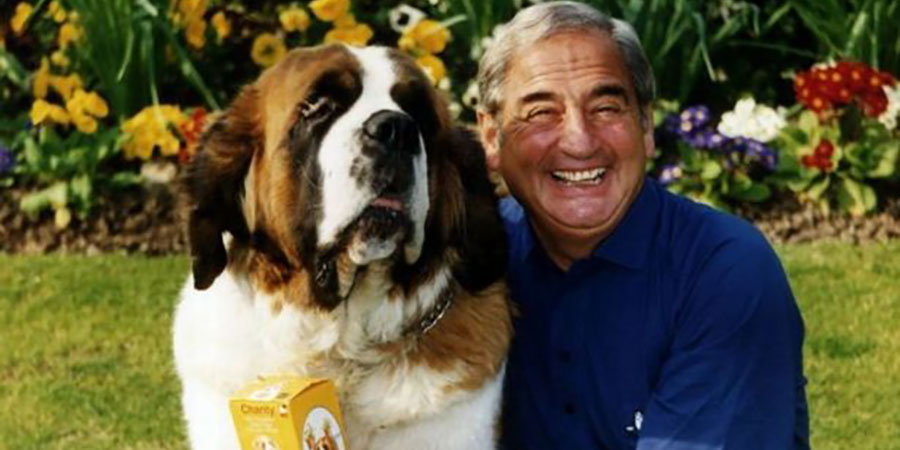
There have been some improbable comic performers over the years: take, for example, Peter Brough, the lip-moving radio ventriloquist; or Tony Holland, who flexed his muscles to a tune called Wheels Cha-Cha; or Bob Blackman, who sang Mule Train with tremendous passion whilst repeatedly hitting himself about the head and neck with a metal tea tray. Perhaps the most improbable of them all, however, was a dog called Schnorbitz.
Schnorbitz, a 14 stone St Bernard bitch, found fame without doing anything at all except continuing to exist as a 14 stone St Bernard bitch. At least the likes of Tony Holland temporarily twitched a few muscles, and Bob Blackman smacked himself senseless with a household accessory. They were profoundly limited as performers, but at least they made a modicum of effort.
Schnorbitz, in contrast, made no effort at all. From start to finish, she had zero complicity in her own stellar canine career. Chronically immobile, incurious and impassive, she became popular merely by lying there and allowing her essential Platonic dogness to be captured on camera on a regular basis.
There is a kind of Rashomon-style clash of perspectives when it comes to judging the show business career of Schnorbitz. To some, it is a sobering parable about the cynical manipulation of innocent performers; to others, a heart-warming tale of unexpected and unlikely success; and to a few, a subtly subversive anticipation of the age of vloggers, reality stars and Gemma Collins.
It all began for Schnorbitz, quite out of the blue, in 1978, when the brothers Mike and Bernie Winters broke up as a comedy double act. Mocked throughout much of their shared career - the reaction to Bernie's delayed emergence from behind the curtains at the Glasgow Empire, 'Oh, Christ, there's two of 'em!' became the standard sarcastic response to the sight of any similarly unwelcome combination, and even The Beatles ended up teasing them on live TV ('What about The Mike Winters Six?' Mike had suggested as the name for their proposed super group. 'I don't think so,' ad-libbed George Harrison. 'For me, The Eric Morecambe Six sounds much better') - their professional partnership perished eventually thanks to the permafrost that pervaded their personal relationship.
In 1970, Mike Winters had suffered a breakdown and left his brother to perform a summer season alone. Then, a couple of years later, the pair argued bitterly after their latest TV show, a joyless sitcom called Mike And Bernie, received a critical mauling. With other tensions creeping along behind the scenes, including those relating to Mike's increasingly obvious distaste for Bernie's long-running affair with a dancer twenty years his junior, they agreed to quit - but only after their father (their biggest fan) died, which would not be until 1977.
In the summer of 1978, therefore, the warring Winters belatedly went their separate ways. Mike left show business, and Britain, for a new life in Florida, where, amongst other things, he ran a nightclub, worked for a production company, took to writing thrillers and helped organise black-tie boxing events. Bernie, meanwhile, stayed put and resolved to go on as a solo performer.
Fortunately for him, his genial personality had won him many friends over the years who remained loyal to him once the double act had gone into decline, and one of the most influential of these allies was Philip Jones, who ran the light entertainment department at Thames Television. It was thanks to Jones that Bernie Winters was now placed in the eminently capable hands of the producer John Ammonds - the man who, ironically enough, had previously been responsible for helping to make Morecambe & Wise so much more popular than Mike and Bernie Winters.
Ammonds, who had only recently joined Thames from the BBC, had never in his wildest dreams, or nightmares, expected to be charged with the task of reviving the career of one half of his old friends' rival double act, but he threw himself into the project with his usual professionalism, and was pleasantly surprised by how open to direction his new star seemed to be: 'I must say I found Bernie to be very co-operative, and very hard-working,' he later recalled. 'It gave me hope that we could work something out.'
The initial challenge, however, was to overcome the basic conundrum: 'Funny man, now without a straight man, for the first time in over thirty years, suddenly sadly rootless - what to do?' It was easier to work out the negatives than the positives.

'To begin with,' Ammonds would confirm, 'I wasn't quite sure what to do with him. And I'm not actually sure if he knew what to do with himself! I mean, he'd been part of a double act for so many years, and that had defined him, so we weren't entirely sure how to use him in his own show. He couldn't just do what he used to do, all of that "Eeeee, Choochie-Face!" stuff! So we had to have a think about it all.'
It took about a fortnight or so of brainstorming, but a solution was finally found. 'Eventually,' said Ammonds, 'I decided on a format in which we'd basically have four sketches per show, and Bernie would link them. But I still felt he needed someone or something to play off. I didn't want him to be completely alone. He was still too "jumpy" for what I wanted.'
This was where what we might care to call 'The Ammonds Touch' came in to play. John Ammonds, in addition to being one of the most sharp-minded and shrewd of producers, was also a master of conceiving a small but diverting detail that would catch the eye and, in a subtle way, convey and clarify something of the personality of a comic performer.
It was his idea, for example, to begin Harry Worth's shows with a much-mimicked optical illusion, involving his 'levitated' reflection in a shop window, and it was his idea to get Val Doonican to croon one song each week sitting in the rocking chair that ended up being his trademark. Most famously of all, it was his idea to have Morecambe & Wise dance off their show each week by adapting the gestures he had seen Groucho Marx perform in the movie Horse Feathers.
He now came up with a similarly inspired touch to embellish his current star's image. This time he brought in a dog.
'I knew Bernie liked dogs,' he later explained, 'and I happened to notice when he was around them that he seemed more relaxed and less self-conscious, so I thought, well, why not try him out with a dog? Because, you see, I knew that Bernie had been used to being quite frenetic alongside Mike, he tended to play it quite broadly, and I didn't want that when he was linking the sketches. I wanted him to be much more natural, and I knew he'd have to calm it down when he'd got a great big dog sitting next to him. So we got this St Bernard dog from an agency that provided animals that could perform in front of the cameras. Everyone would end up thinking it was Bernie's own dog but we got it for him.'
Winters, when Ammonds first suggested the idea, was not exactly convinced that it was something that he wanted to try. 'His face was a picture! I suppose he was thinking, "I've only just got out of a double act, and now this man wants to put me straight into another one - and this time with a dog!"' Once he saw the size and look of the animal in question, however, its potential as a 'straight-dog' was obvious, and he was ready to trust Ammonds's judgement.
At first, Schnorbitz's job was simply to fill the space where Mike Winters no longer was. Her job was merely to be the 'Not-Mike' by Bernie's side.
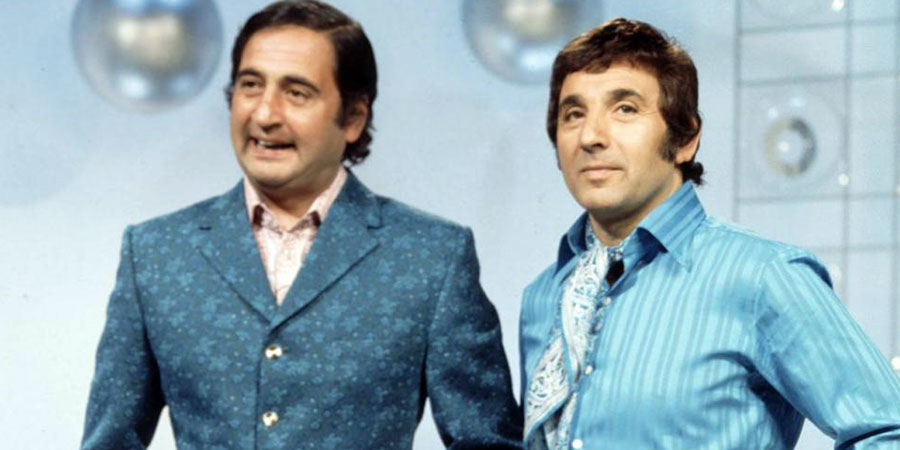
She did the job perfectly well. There were no tantrums, no tricks, not even a peep-bo with a paw. She just sat there like a statue. Bernie, now free from all of the old festering sibling tensions, finally had a silent, submissive and pliable partner, and he enjoyed the feeling of being in complete control.
The new show (which started in October 1978) was billed as Bernie, and he certainly intended and expected it to be a solo starring vehicle, but it soon evolved into something rather different - and it was the dog that did it. Schnorbitz, simply by slumping wearily at his side, not only helped make Winters seem warmer, but she also won over all of the dog lovers who watched. Within a few weeks of the show making its debut, it started to be referred to by the tabloids - whether Winters wanted it or not - as the 'Bernie and Schnorbitz show'.
Whatever he may have felt about being dragged back into a double act, Winters was bright enough to realise that it would be foolish not to go with the flow. This great big lugubrious-looking dog was not only winning back his old fans, but she was also making new ones out of some of those (women especially, according to research conducted at the time) who had never felt much or any affection for him when he was still with his previous partner. In a strange sort of way, therefore, the dog was humanising the human.
Thrilled by this turn of events, Winters threw himself into his arranged marriage with Schnorbitz, eagerly becoming its myth-maker-in-chief. The role played by John Ammonds, and the animal agency, was promptly erased in favour of a fanciful story about how Bernie had bought the dog at the tender age of eight months and then quite deliberately schooled her in the ways of show business so that she could join him one day on the stage.
Once that tale took root, he made sure that he was pictured with the dog whenever and wherever possible, and the tabloids lapped it all up: how Bernie and Schnorbitz were inseparable; how he fussed over her daily sausage intake (no more than four pounds a day, he insisted, 'plus biscuits and other doggie food'); how he searched for suitable places for them to 'go walkies'; and how he felt she 'talked' to him rather than merely emitted the odd noise.
There was never any doubt that he genuinely liked and cared for the dog (along with his own pet, a three-year-old German Shepherd, which for a long time remained hidden at home), but he was canny enough with this canine to ensure that, without any input from her, the myth would grow into something increasingly sharp and marketable.
It worked. Within a year or so, Bernie and Schnorbitz were a bona fide show business item.
They did not just share their own TV show. They were also in demand for personal appearances, cabaret shows, summer seasons, plays and pantomimes. In 1979, Schnorbitz was formally billed as 'co-presenter,' alongside Bernie, of the ITV hybrid circus/comedy series The Big Top Variety Show.
By 1980, the Schnorbitz story, with grim inevitability, took a dramatic turn when it was reported that the in-demand dog had started to feel the show business schedule such a strain that she had needed to take several days off at an 'animals' rest home' somewhere in Sussex. 'He's [sic] made 150 appearances in the past eighteen months,' a Thames TV spokesman told the tabloids, 'and worked harder than a lot of humans'.
Once this rite of passage had been navigated, Schnorbitz was back in the spotlight with a vengeance. She had her own contracts, negotiated on her behalf by Bernie's redoubtable German wife, Siggi; was chauffeured around London in a specially-extended Rolls-Royce; and socialised with her fellow stars on a regular basis (on one occasion falling into Terry Scott's swimming pool only to be rescued by Barbara Windsor).
Billy Smart's Circus announced plans to use her for a wide range of promotional purposes, starting with the first shake and pour of the 'Schnorbitz Cocktail' at a fashionable Mayfair club. Other marketing ventures followed, including Schnorbitz T-shirts, pens and pencils, toys, dog bowls and many more types of potentially lucrative merchandise. Bernie Winters also let it be known, rather improbably, that Schnorbitz had been made a co-director of one of his companies.
It helped, as far as the television appearances were concerned, that the dog could be relied upon to remain so strikingly docile. Directors, who would normally have avoided animals like the plague because of their seemingly in-built penchant for running around and causing chaos, competed with each other to get Schnorbitz on their shows. She even stayed utterly unfazed when she accompanied Winters to plug a brand of sausages - yet another commercial venture - on a programme hosted by Rod Hull and Emu. Whilst Winters had to endure the obligatory physical attack from the tiresomely volatile arm puppet, Schnorbitz munched contentedly on the meat without so much as a glance at the noisy kerfuffle that had broken out all around her.
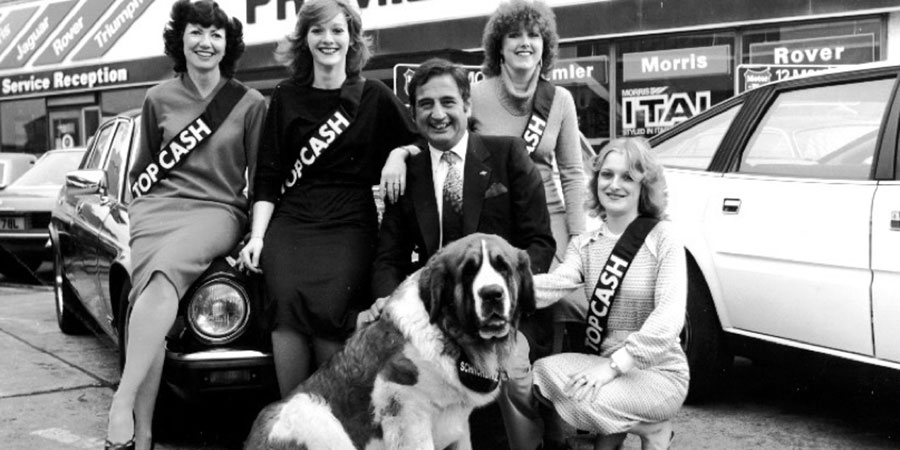
As a result, the projects kept on coming. After Bernie and Big Top came the somewhat bizarre 1985 vehicle Whose Baby? - a low-budget game show that saw Bernie and Schnorbitz invite celebrity guests to identify other stars by scrutinising their images as infants. Once again, Bernie would chatter toothily away whilst Schnorbitz, her tongue hanging out like a mini red carpet, would occupy a large amount of space nearby in a seemingly semi-comatose state which some kind-hearted critics decided to describe as a sign of 'her languid charm'.
The two of them also became, for a while, the faces of ITV's children's output, introducing such evanescent gems as Tickle On The Tum[/o], featuring the folk-pop singer Ralph McTell as the musical chronicler of quaint village goings-on, and [i]The Telebugs, a sci-fi cartoon series about robots with sundry speech defects. This further expansion of their demographic appeal helped Schnorbitz to win a special gold medal for being voted 'The Most Loveable Pet of the Year' in a national competition sponsored by the Pro Dogs charity ('We have to honour her,' declared a somewhat grudging-sounding organiser, 'because of public demand').
By 1986, the burgeoning fame of Schnorbitz was doing strange things to Bernie Winters. In one newspaper interview, for example, he sounded as though he had transcended himself and his dog and was observing the two of them from some peculiar spectral position. 'I'm not sure who actually performed the opening ceremony,' he told reporters of their latest garden fete. 'I think it was Bernie.'
It was at this stage, however, that the sheer passivity of Schnorbitz, which had previously been such a strength, suddenly seemed such a weakness, because her partner began to pull the strings to his, rather than her, advantage. Whilst continuing to praise his eight-year-old co-star to the skies, Bernie Winters now started dropping into the conversation that he had recently taken ownership of a four-month-old miniature Yorkie named Putzi. 'Putzi has already made her debut on television,' he said, rather ominously. 'She and Schnorbitz were seen with me when I hosted a Disneytime programme not long ago.'
The demise was difficult to see coming, seeing as the dog had been so inanimate for so long, but in 1987, in the final edition of that series of Whose Baby, with no sign on screen of Schnorbitz, a beaming Bernie Winters introduced another dog that he called 'Baby Schnorbitz'. It was later revealed, very briefly and matter-of-factly, that Schnorbitz had in fact died, and 'Baby Schnorbitz' had been hired to take her place.
There was, given the fame that Schnorbitz Senior had achieved, surprisingly little comment on her passing. It would merely be a matter of months before 'Baby Schnorbitz' was being referred to simply as 'Schnorbitz,' and life went on as if no one, and no dog, had been lost.
There were more than enough visual clues to reveal the ruse - Schnorbitz 2.0 was smaller, thinner and considerably more active and alert than the real, classic, original Schnorbitz - but it was as if both the public and the press were in denial about the duplicity, and so the doppelgänger double act was allowed to carry on as usual. The offers thus kept coming in, and they ended the year strongly enough by co-starring alongside Larry Grayson in a high profile pantomime - Dick Whittington at the Alexandra Theatre in Birmingham - but there was already evidence that the new Schnorbitz was not going to be quite as conveniently docile and dutiful as the old one.
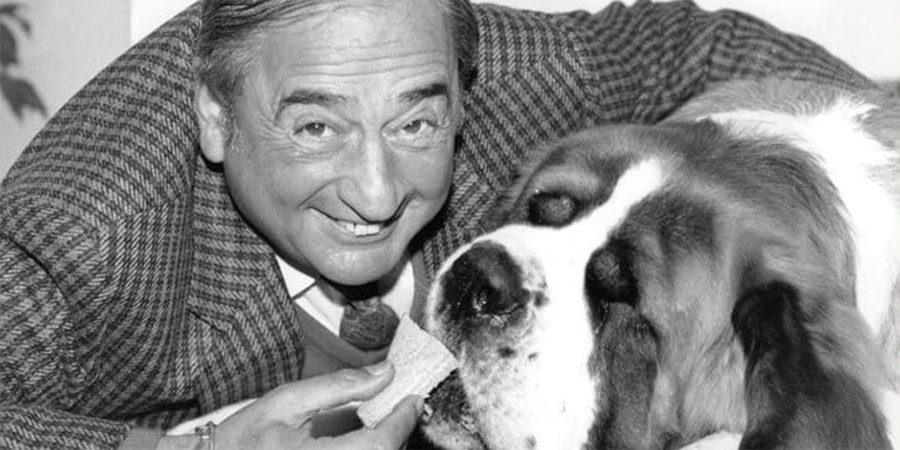
In 1988, for example, it was reported that the second Schnorbitz - who was appearing with Winters in summer season in Torquay - had been 'ordered to rest' after leaping out of the first floor window in Bernie's hotel apartment and fracturing her shoulder after falling twenty feet to the pavement. Whether this incident signified a desperate cry for help from a reluctant performer, or a petulant reaction to her co-star's sudden decision to supplement their act with the introduction of a six-inch high Chihuahua called Cheeky, or was simply a by-product of being a more youthful, energetic and danger-seeking dog than her predecessor, remained a matter for conjecture.
What was beginning to be clear, however, was that the act was, slowly but surely, falling out of fashion. The TV series had gone, and even the one-off appearances were drying up, and, aside from the annual pantomimes, Bernie and the ersatz Schnorbitz were now spending more and more of their time slumming in that semi-hidden dimension of show business that includes opening supermarkets and shopping malls, supporting local charities and schools, and popping up every now and again in the smaller clubs.
One sobering sign of how the cultural mood was changing occurred at the start of the 1990s, when Julian Clary, one of a new breed of comedian who had first made a name for himself by appearing alongside his own canine sidekick, Fanny the Wonderdog, 'outed' Schnorbitz as an imposter while sneering at Winters for resorting to such old school subterfuge. 'Oh no,' Clary snapped when asked if he might ever try a similar trick with a fake Fanny, 'I've got ethics!'
There was still, however, one last twist left in this strange little story. The double act finally ended abruptly on 4 May 1991, when Bernie Winters, after a relatively short period of illness, passed away aged just sixty; but, surprisingly, this was not quite the end of Schnorbitz's own career in show business.
Winters, it was soon revealed, had actually bequeathed the second Schnorbitz, the pseudo-Schnorbitz, to Richard De Vere, a flamboyant Blackpool-based illusionist whom Bernie had discovered a few years before at a Pontins holiday camp. 'I went to the will reading,' De Vere would say, 'and while everyone else got money, I ended up with Schnorbitz, and wondered what I was going to do with a 14 stone St. Bernard.'
Feeling obliged to his former mentor, De Vere duly incorporated Schnorbitz into his own stage act, and found a succession of inventive ways to use her each Christmas in his popular northern pantomimes, as well as during summer seasons. There were various other public-pleasing ventures, such as The Schnorbitz Trust, which he set up to help provide minibus transport for local under-privileged or disabled children. He even, in time, managed to arrange for a bronze statue of himself and Schnorbitz to be installed on Blackpool's promenade. Thanks to De Vere, therefore, the dog stayed in the picture.
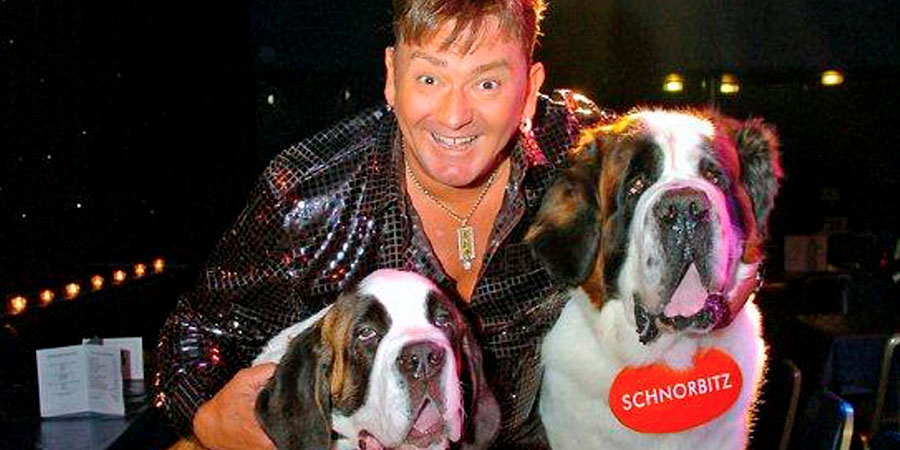
Without her old comedy co-star, however, Schnorbitz never seemed quite the same, and, while the audiences continued to applaud her politely, she was not as popular behind the scenes with her fellow performers - many of whom resented having to share the stage, and more importantly the backstage, with what was by now an overweight and elderly animal with one or two less than endearing personal habits.
One of those who suffered from toiling alongside Schnorbitz in her twilight years was the Liverpudlian radio presenter Pete Price. He joined Richard De Vere and his dog at the end of 2005 for a production of Jack and the Beanstalk at his home city's Royal Court Theatre. 'I played Simple Simon,' Price would recall. 'Richard was the baddie. The juvenile dancers had a routine to dance around me while Richard built a little house with me in the middle. He then "changed" me into the dog.'
It might have been magical for the audience, but it was painful for Price: 'When the roof was put on, Schnorbitz was smuggled in, so the two of us were in this ridiculous confined space. Every performance the dog would slobber on me and pass wind. It's a smell that will stay with me forever. I hated that dog.'
It was, alas, a sentiment that was shared by a growing number of Schnorbitz's fellow performers, and, by this stage, it was clear that her days on stage were coming to a close. Her latest owner, however, was not finished yet. Like a scientist in an old Hollywood movie who had become unhinged by the monster he had created, Richard De Vere started phasing out Schnorbitz the Second and phasing in Schnorbitz the Third - a male dog, this time, and, apparently, the grandson of Schnorbitz the First.
So there would still be some or other Schnorbitz on stage until De Vere himself died in 2014. What happened after this to the dogs has never been disclosed, but, given their remarkable powers of survival and Doctor Who-like potential for regeneration, it seems possible that, even now, there could still be a Schnorbitz somewhere close to you.
What, however, does the story of Schnorbitz, or the Schnorbitzes, tell us, if anything, about our attitude to popular culture? It could be that we are rather more easily and enduringly entranced by the brand, rather than the original idea or unique individual, than we would care to admit; or that who we think of as a star, not always but often, has more to do with who fills the right role, or hole, at the right time than it does with who does anything genuinely essential or special; or that the show business world is actually less dog eat dog than it is dog swap dog.
It surely also sends out a message to all of those other celebrities whose fame is founded on not doing much more than being themselves, and that message is: enjoy it while you can, with a decent degree of humility, because one day, whether you like it or not, you will almost certainly be replaced - and even your own fans might not notice that you've gone.
Help us publish more great content by becoming a BCG Supporter. You'll be backing our mission to champion, celebrate and promote British comedy in all its forms: past, present and future.
We understand times are tough, but if you believe in the power of laughter we'd be honoured to have you join us. Advertising doesn't cover our costs, so every single donation matters and is put to good use. Thank you.
Love comedy? Find out more
